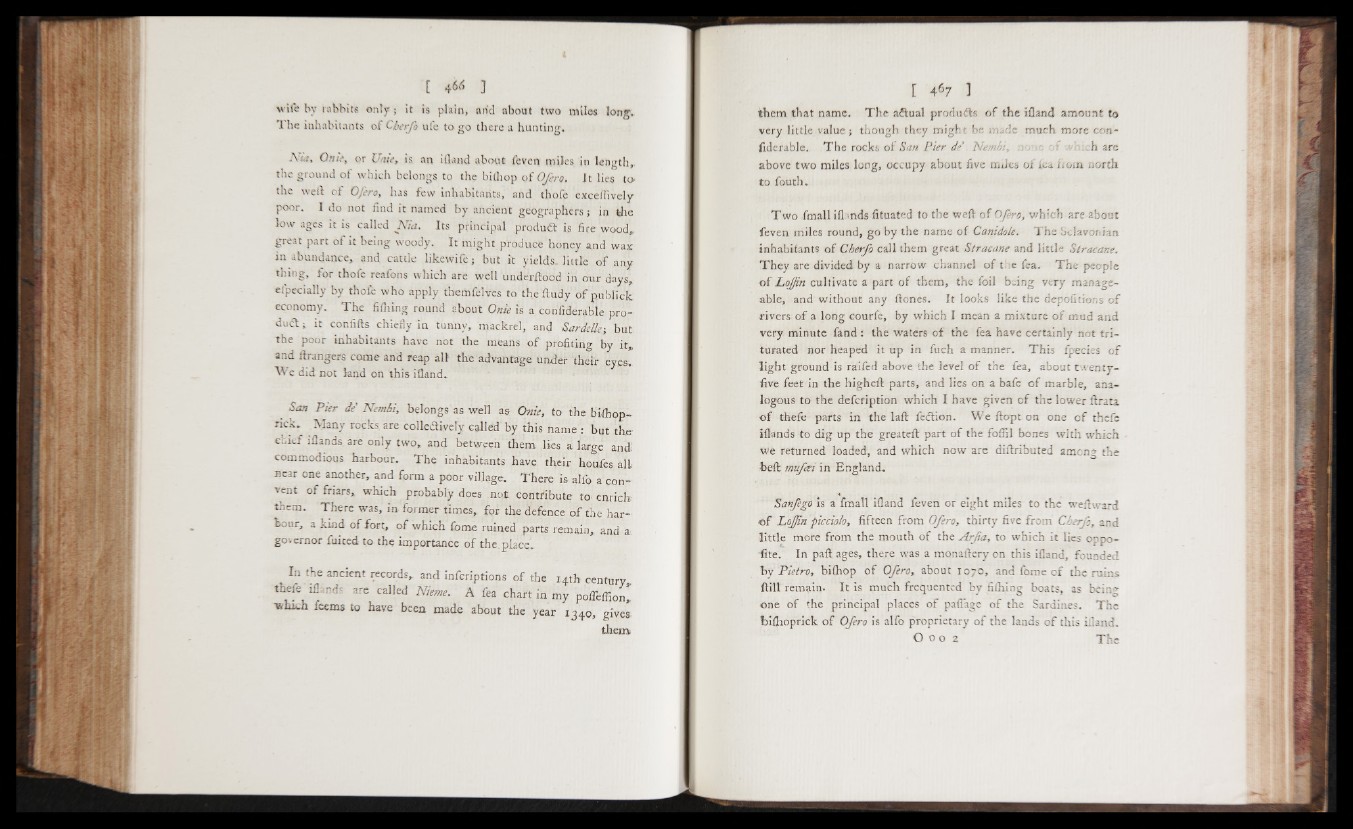
wile by iabbits o n ly ; it is plain, and about two miles long.
The inhabitants o f Cherfo ule to go there a hunting.
Am, On if, or Unit, is an ifland about feven miles in length,,
the ground o f which belongs to the bilhop o f Ofero, It lies to-
the weft o f Ofero, has few inhabitants, and thofe exceflively
poor. I do not find it named by ancient geographers; in the
low ages it is called Nia. Its principal product is fire wood,
great part o f it being woody. It might produce honey and wax
in abundance, and cattle likewife; but it yields, little o f any
thing, for thofe reafons which are well underftood in our days,
elpecially by thofe who apply themfelves to theftudy o f publick
economy. The fiihing round about Onie is a confrderable pro-
du dl ; it confifts chiefly in tunny, mackrel, and Sardelle-, but
the poor inhabitants have not the means o f profiting by it,
and ftrangers come and reap all the advantage under their eyes.
We did not land on this ifland.
San Pier de' Nembi, belongs as well as Onie, to the bilhop-
nek. Many rocks are colleöively called by this name : but the
ebief ¡Hands are only two, and between them lies a large and:
commodious harbour. The inhabitants have their houfes all
near one another, and form a poor village. There is alio a convent
o f friars, which probably does not contribute to enrich
them. There was, in former times, fpr the defence o f the harbour,
a kind o f fort, o f which fome ruined parts remain, and a.
governor fuited to the importance o f the place.
In the ancient records, and infcriptions o f the 14th century
thefe iflands are called Nieme. A fea chart in my pofleffion!
which feems to have been made about the year 1340, gives.
them
them that name. T he ailual produdls o f the ifland amount to
very little value; though they might be made much more con-
fidcrable. The rocks o f San Pier de’ Nembi, none of vhich are
above two miles long, occupy about five miles oi fea from north
to fouth.
Tw o fmall ill nds fituated to the weft of Ofero, which are about
feven miles round, go by the name of Canidole. The Sclavonian
inhabitants o f Cherfo call them great Stracane and little Stracane.
They are divided by a narrow channel of the fea. The people
o f Loffin cultivate a part o f them, the foil being very manageable,
and without any ftones. It looks like the depositions o f
rivers of a long courfe, by which I mean a mixture o f mud and
very minute fand: the waters of the fea have certainly not triturated
nor heaped it up in fuch a manner. This fpecies o f
light ground is raifed above the level o f the fea, about twenty-
five feet in the higheft parts, and lies on a bale o f marble, analogous
to the defcription which I have given o f the lower ftrata
o f thefe parts in the laft feilion. We ftopt on one o f thefe
iflands to dig up the greateft part o f the foffil bones with which
we returned loaded, and which now are diftributed among the
beft mufxi in England.
Sanfego is a fmall ifland feven or eight miles to the weftward
o f Lojfn picciolo, fifteen from Ofero, thirty five from Cherfo, and
little more from the mouth of the A r fa , to which it lies oppo-
fite. In paft ages, there was a monaftery on this ifland, founded
by Pietro, bilhop o f Ofero, about 1070, and fome o f the ruins
ftill remain. It is much frequented by fiihing boats, as being
one o f the principal places o f paflage o f the Sardines. The
bifhoprick of Ofero is alfo proprietary o f the lands o f this ifland.
O 00 2 The